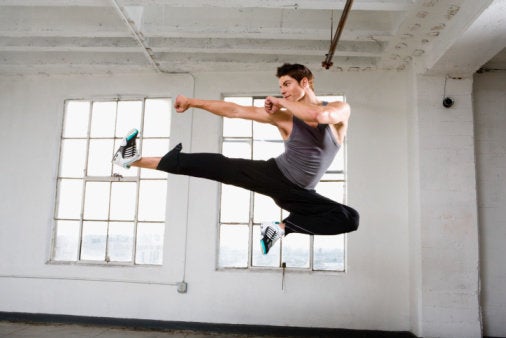
Kung-fu is an art that entails not only self defense skills and getting in shape, but also teaches about the development of mind, body and spirit and how one can grow in all aspects of life. When our personal awareness is cultivated from within these three areas, it will reflect in our relationships with all people, the planet and the universe. In China, the spiritual and physical realms are traditionally not seen as separate.
In martial arts an important grounding force is learning to originate all your moves from the tan tian, (known as the sea of chi.) The psychic center that protects the center of gravity and produces a reservoir of force from which one can draw energy. It is located about two inches below the navel and inward in the body. In the martial arts tradition, it is the source of all power; our life force. Chi is defined as energy that can be directed through visualization from the tan tien to places outside the body. It is from this center that martial artists draw power to break concrete. When you study martial arts, you learn to use the breath to create a connection between the mover and the movement. Sometimes, when we are under pressure, threatened or intimidated, we move away from our power center into our head, where we can undermine ourselves. This rooting power centers the mind and body, so it is difficult to be dislodged or intimidated. From here you are able to control your mental states.
In martial art classes, white belts can be the most dangerous to spar with and are most likely to hurt you. Once while sparring with a white belt ground fighter, I had the advantage and this outraged my opponent. She lost control and flipped my legs behind my head, putting her full weight on me until my sternum separated from my ribs. I had to be rushed to the emergency room. A highly ranked martial artist will remain calm, unemotional and will have mastered their ego. It would be safest to spar with a partner such as this.
The spirit and feeling in training should be harmonious, working together as partners, not opponents. Working with another person helps both progress more rapidly. Working against someone is dangerous, as a calm disposition is essential in order to act with accurate judgment of your partner's movement.
Success is measured not by rank, but how the student's life improves. By learning to manage energy and emotions, and letting go of the need to be right, students become masters over their actions, rather than prisoners of their reactions. In ancient cultures, students studying martial arts disciplines did not practice to obtain a rank or belt. They practiced to develop themselves physically, mentally and spiritually. In Kung-fu, T'ai Chi and Karate the competitor seeks to lose all distractions of ego, analysis and self-referring thoughts, immersing him or herself completely within the activity. This is also known as being in the zone or flow.
In life there are many levels on which we can be attacked, but not just physically. Being centered physically reflects in being centered emotionally. How this translates into daily life is by not overreacting, avoiding conflict, standing ground, and allowing others to have their opinion without feeling like you have to convince them that you are right.
If you allow yourself to become defensive, a cycle is set in motion and, before you know it, the conflict has spiraled into negativity that has nothing to do with the truth at hand. Instead of making people over in a certain image or trying to force them to do things in a certain way, if we practice detachment, compassion and acceptance we create harmony. This positive state of mind prevents us from getting pulled into things that don't serve us or the higher good.
Part of the training in martial arts includes learning how to fall and to trust that you won't get hurt. We are often afraid of falling and hurting ourselves literally and figuratively. This can manifest as common fears ... fear of failure, falling in love and of the unknown. In all of our lives we sometimes fall or feel out of control. Learning how to fall physically without hurting yourself and bouncing right back up is an empowering lesson that teaches us we can come back from anything with speed and wisdom.
In meditation or moving meditation, we have access to an inner sanctuary to retreat; a safe haven, a place no one can ever touch or destroy, available to us at any time.